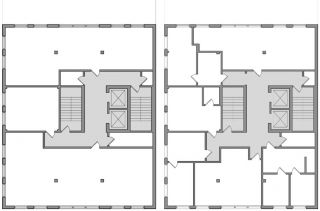
www.buildingsandcities.org/insights/news/built-environment-planetary-boundaries.html
Creating a Built Environment within Planetary Boundaries

RESEARCHERS DECLARE! A series of specific recommendations for action were recently created by the research community for policymakers, industry and society.
These recommendations and actions focus on the assessment and reduction of environmental & climate impacts and resource consumption over the life cycle of buildings.
Rolf Frischknecht (Treeze Ltd) and Thomas Lützkendorf (Karlsruhe Institute of Technology) introduce the Monte Verità Declaration and discuss some of its implications for those working in the built environment.
Given the urgency of the climate crisis and the need for coordinated action, an expert group [1] of more than 40 researchers from 20 countries agreed on a wide set of recommendations which support policy, industry and society in reaching net zero GHG emissions. The recommendations are targeted on a wide range of actors: governments and administrations; investors, financial institutions; research organisations; designers, architects and engineers; operators of EPD programs, sector specific LCA databases, certification schemes and labels; construction product and building technology manufacturers; construction companies; real estate agents; as well as users and tenants of buildings.
The Monte Verità Declaration (IEA EBC Annex 72 experts 2021) and its recommendations focus on the assessment and reduction of environmental impacts and resource consumption over the life cycle of buildings. This is the core topic of the experts and their research institutes co-operating in IEA EBC Annex 72. While the declaration has a special focus on GHG emissions and related impacts on global environment, further environmental impacts include the use and depletion of natural resources and impacts on local environment are also addressed to avoid burden shifting.
The Monte Verità Declaration builds on the Graz Declaration of Climate Protection in the Built Environment (SBE19 2019) by providing specific recommendations for action.
One of the key recommendations, addressed to governments and administration, is the introduction of legally binding requirements to limit GHG-emissions of new constructions and of refurbishments by 2025 latest with a roadmap to net zero emissions by 2035. The recommendation is to enlarge the regulation of GHGs from operational energy to include embodied emissions from the supply chain and to cover the full life cycle of the building (see also Lützkendorf & Frischknecht 2020; Satola et al. 2021).
Transparency and directionality are needed in the area of balancing and compensation. Existing approaches differ in the level of ambition. Some countries and labelling schemes assume that exported energy (e.g. electricity from photovoltaics attached to buildings) reduces electricity generated from fossil fuels and those potentially avoided emissions may be used to compensate the GHG emissions of those buildings. Others recommend to buy CO2 emission certificates to compensate for the remaining GHG emissions of the building. In accounting terms both approaches are - from point of view of the authors of this contribution - likely to lead to increased GHG emissions elsewhere. A third option is to invest in negative emission technologies which remove CO2 from the atmosphere or biogenic CO2 from flue gases and permanently sequester it. While this option would allow for truly net zero buildings it is technically not yet proven at large scales.
Is the request for the introduction of legally binding requirements until 2025 with a decarbonisation path until 2035 realistic? Yes, some activities are going already in this direction. Several European countries introduced or will soon introduce binding requirements to limit the GHG emissions over the life cycle of buildings. This legislative process shall be and is being supported by parallel activities, in particular the supply and testing of LCA databases and design tools, the education and training of the actors involved as well as the revision of real estate tools (valuation, tenancy laws). All actors, including manufacturers and suppliers, investors, designers and educators are dependent on an early publication of a binding reduction pathway from 2025 to 2035. Some actors may need reliable funding programmes to help make the transition.
While some countries have clear and practical rules, certified design tools and reliable LCA data available, others are in need of these resources.
Without compromising the urgent need for legally binding requirements and a reduction path to net zero GHG emissions by 2035, from point of view of the authors the following questions among others require further refinement of the modelling and assessment rules:
- Is it feasible and useful to change from static to more dynamic models used for the quantification, assessment and verification of GHGs emitted over the life cycle of buildings? Would dynamic models be susceptible to manipulation or overly optimistic scenarios?
- Is it feasible and useful to limit the GHG emissions caused by the initial efforts as they occur now and reduce the remaining available emission budget?
- Is it feasible and useful to better align the calculation, modelling and assessment rules with national energy GHG emission statistics or with national sustainability strategies?
- Is it feasible and useful to enlarge the system boundary to neighbourhoods and even beyond? What would be the consequences for the design targets of individual buildings?
The authors recommend to go even beyond the contents of the Monte Verità Declaration and address these topics. They are convinced that the research community has an important, urgent role to provide clear evidence.
Note
[1] Visit https://annex72.iea-ebc.org/ for further information about the experts involved and for guidelines and recommendations (expected to be published in late 2022).
References
Frischknecht R., Birgisdottir H., Chae C.U., Lützkendorf T. and Passer A. (2019). IEA EBC Annex 72 - Assessing life cycle related environmental impacts caused by buildings - targets and tasks. In: Proceedings of Sustainable Built Environment D-A-CH Conference 2019, Graz, Austria. IOP Conference Series: Earth and Environmental Science, 323, 012042. http://dx.doi.org/10.1088/1755-1315/323/1/012042.
IEA (2021) Net Zero by 2050: A Roadmap for the Global Energy Sector. Paris: International Energy Agency.
IEA EBC Annex 72 Experts (2021). The Monte Verità Declaration on a Built Environment within Planetary Boundaries. IEA EBC Annex 72 experts, Monte Verità, Ticino, Switzerland.
Lützkendorf T. and Frischknecht R. (2020). (Net-) zero-emission buildings: a typology of terms and definitions. Buildings and Cities, 1(1), pp. 662-675, http://doi.org/10.5334/bc.66.
Satola D., Balouktsi M., Lützkendorf T., Houlihan Wiberg A. and Gustavsen A. (2021). How to define (net) zero greenhouse gas emissions buildings: the results of an international survey as part of IEA EBC annex 72. Building and Environment, 107619. http://doi.org/10.1016/j.buildenv.2021.107619
SBE19. (2019). Graz Declaration for Climate Protection in the Built Environment. In: Proceedings of the Sustainable Built Environment D-A-CH Conference 2019. (11-14 September 2019). Graz: Graz University of Technology.
Latest Peer-Reviewed Journal Content
A living lab approach to co-designing climate adaptation strategies
M K Barati & S Bankaru-Swamy
Mediation roles and ecologies within resilience-focused urban living labs
N Antaki, D Petrescu, M Schalk, E Brandao, D Calciu & V Marin
Negotiating expertise in Nepal’s post-earthquake disaster reconstruction
K Rankin, M Suji, B Pandey, J Baniya, D V Hirslund, B Limbu, N Rawal & S Shneiderman
Designing for pro-environmental behaviour change: the aspiration–reality gap
J Simpson & J Uttley
Lifetimes of demolished buildings in US and European cities
J Berglund-Brown, I Dobie, J Hewitt, C De Wolf & J Ochsendorf
Expanding the framework of urban living labs using grassroots methods
T Ahmed, I Delsante & L Migliavacca
Youth engagement in urban living labs: tools, methods and pedagogies
N Charalambous, C Panayi, C Mady, T Augustinčić & D Berc
Co-creating urban transformation: a stakeholder analysis for Germany’s heat transition
P Heger, C Bieber, M Hendawy & A Shooshtari
Placemaking living lab: creating resilient social and spatial infrastructures
M Dodd, N Madabhushi & R Lees
Church pipe organs: historical tuning records as indoor environmental evidence
B Bingley, A Knight & Y Xing
A framework for 1.5°C-aligned GHG budgets in architecture
G Betti, I Spaar, D Bachmann, A Jerosch-Herold, E Kühner, R Yang, K Avhad & S Sinning
Net zero retrofit of the building stock [editorial]
D Godoy-Shimizu & P Steadman
Co-learning in living labs: nurturing civic agency and resilience
A Belfield
The importance of multi-roles and code-switching in living labs
H Noller & A Tarik
Researchers’ shifting roles in living labs for knowledge co-production
C-C Dobre & G Faldi
Increasing civic resilience in urban living labs: city authorities’ roles
E Alatalo, M Laine & M Kyrönviita
Co-curation as civic practice in community engagement
Z Li, M Sunikka-Blank, R Purohit & F Samuel
Preserving buildings: emission reductions from circular economy strategies in Austria
N Alaux, V Kulmer, J Vogel & A Passer
Urban living labs: relationality between institutions and local circularity
P Palo, M Adelfio, J Lundin & E Brandão
Living labs: epistemic modelling, temporariness and land value
J Clossick, T Khonsari & U Steven
Co-creating interventions to prevent mosquito-borne disease transmission in hospitals
O Sloan Wood, E Lupenza, D M Agnello, J B Knudsen, M Msellem, K L Schiøler & F Saleh
Circularity at the neighbourhood scale: co-creative living lab lessons
J Honsa, A Versele, T Van de Kerckhove & C Piccardo
Positive energy districts and energy communities: how living labs create value
E Malakhatka, O Shafqat, A Sandoff & L Thuvander
Built environment governance and professionalism: the end of laissez-faire (again)
S Foxell
Co-creating justice in housing energy transitions through energy living labs
D Ricci, C Leiwakabessy, S van Wieringen, P de Koning & T Konstantinou
HVAC characterisation of existing Canadian buildings for decarbonisation retrofit identification
J Adebisi & J J McArthur
Simulation and the building performance gap [editorial]
M Donn
Developing criteria for effective building-sector commitments in nationally determined contributions
P Graham, K McFarlane & M Taheri
Join Our Community

The most important part of any journal is our people – readers, authors, reviewers, editorial board members and editors. You are cordially invited to join our community by joining our mailing list. We send out occasional emails about the journal – calls for papers, special issues, events and more.
We will not share your email with third parties. Read more



Latest Commentaries
COP30 Report
Matti Kuittinen (Aalto University) reflects on his experience of attending the 2025 UN Conference of the Parties in Belém, Brazil. The roadmaps and commitments failed to deliver the objectives of the 2025 Paris Agreement. However, 2 countries - Japan and Senegal - announced they are creating roadmaps to decarbonise their buildings. An international group of government ministers put housing on the agenda - specifying the need for reduced carbon and energy use along with affordability, quality and climate resilience.
Building-Related Research: New Context, New Challenges
Raymond J. Cole (University of British Columbia) reflects on the key challenges raised in the 34 commissioned essays for Buildings & Cities 5th anniversary. Not only are key research issues identified, but the consequences of changing contexts for conducting research and tailoring its influence on society are highlighted as key areas of action.